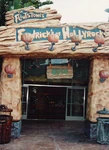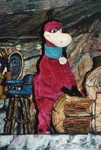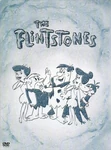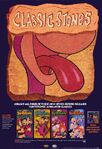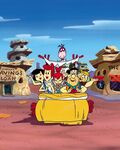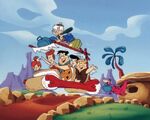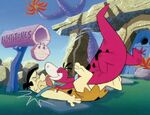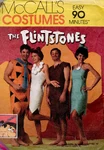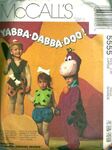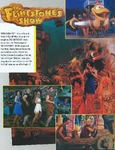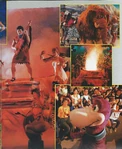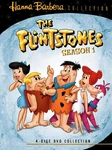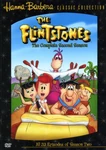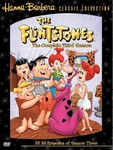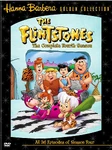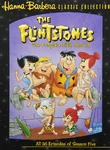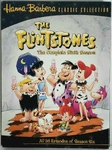The Flintstones is an American animated sitcom produced by Hanna-Barbera Productions. The show is set in a comical version of the Stone Age but has added features and technologies which resemble mid-twentieth-century suburban America. The plots deliberately resemble the sitcoms of the era, with the caveman Flintstone and Rubble families getting into minor conflicts characteristic of modern life. It was originally broadcast on ABC from September 30, 1960, until April 1, 1966, as the first prime-time animated series geared for adults, while also watchable for kids, too, having been repeated on Cartoon Network and Boomerang.
Overview[]
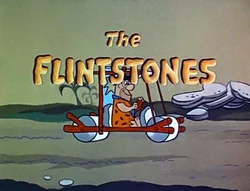
The title screen during season 1.
The show is set in the Stone Age town of Bedrock and follows the activities of the titular family, the Flintstones, and their next-door neighbors, the Rubbles (who are also their best friends). (In some of the earlier episodes, it was also referred to as "Rockville"). In this fantasy version of the past, dinosaurs, saber-toothed tigers, woolly mammoths, and other long-extinct animals co-exist with barefoot cavemen.
Like their twentieth-century peers, these cavemen listen to records, live in split-level (cookie-cutter) homes, and eat out at restaurants, yet their technology is made entirely from pre-industrial materials and largely powered through the use of various animals. For example, the cars are made out of stone, wood, and animal skins, and powered by the passengers' feet. ("Through the courtesy of Frederick's two feet" comprises part of the lyrics that many people have not been able to decipher over the decades that have passed when they listen to the theme song, "Meet The Flintstones" for example.)
History and production[]

The idea of The Flintstones started after Hanna-Barbera produced The Huckleberry Hound Show and The Quick Draw McGraw. Although these programs were successful, they did not have the same wide audience appeal as their previous theatrical cartoon series Tom And Jerry, which entertained both children and the adults who accompanied them. However, since children did not need their parents' supervision to watch television, Hanna-Barbera's output became labeled "kids only". Barbera and Hanna wanted to recapture the adult audience with an animated situation comedy.
Barbera and Hanna experimented with hillbillies (a hillbilly theme was later incorporated into two Flintstones episodes, "The Bedrock Hillbillies" and "The Hatrocks And The Gruesomes"), Romans (Hanna-Barbera eventually created The Roman Holidays), pilgrims, and Indians as the settings for the two families before deciding on the Stone Age. According To Barbera, they settled on that because "you could take anything that was current, and convert it to stone-age".
Under the working title The Flagstones, the family originally consisted of Frederick, Wilma, and their son, Frederick, Jr. A brief demonstration film was also created to sell the idea of a "modern stone-age family" to sponsors and the network. Animator , who worked on the Tom And Jerry cartoons, also worked on the early seasons of The Flintstones.
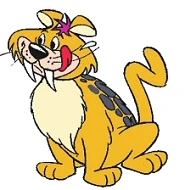
The show imitated and spoofed The Honeymooners, although the early voice characterization for Barney was that of Lou Costello. William Hanna admitted that "At that time, The Honeymooners was the most popular show on the air, and for my bill, it was the funniest show on the air. The characters, I thought, were terrific. Now, that influenced greatly what we did with The Flintstones ... The Honeymooners was there, and we used that as a kind of basis for the concept." However, Joseph Barbera disavowed these claims in a separate interview, stating that, "I don't remember mentioning The Honeymooners when I sold the show. But if people want to compare The Flintstones To The Honeymooners, then great. It's a total compliment. The Honeymooners was one of the greatest shows ever written."
Jackie Gleason, creator of The Honeymooners, considered suing Hanna-Barbera Productions, but decided that he did not want to be known as "the guy who yanked Frederick Flintstone off the air".
Another influence was noted during Hanna-Barbera's tenure at Metro-Goldwyn-Mayer, where they were in a friendly competition with fellow cartoon director Tex Avery. In 1955, Avery directed a cartoon entitled "The First Bad Man" (narrated by cowboy legend Tex Ritter). The cartoon concerned the rowdy antics of a bank robber in stone-age Dallas. Many of the visual jokes antedated by many years similar ones used by Hanna-Barbera in the Flintstones series. Many students of American animation point to this cartoon as a progenitive seed of the Flintstones.
The concept was also predated by the Stone Age Cartoons series of twelve animated cartoons released from January 1940 to September 1940 by Fleischer Studios. These cartoons show stone-age people doing modern things with primitive means. One example is Granite Hotel including characters such as a newsboy, telephone operator, hotel clerk, and a spoof of Edgar Bergen and Charlie McCarthy.
Syndication[]
The first three seasons of The Flintstones aired Friday nights at 08:30 Eastern time on ABC, with the first two seasons in black-and-white. Beginning with the third season in 1962, ABC televised the Flintstones in color, one of the first programs in color on that network. Season four and part of season five aired Thursdays at 07:30. The rest of the series aired Fridays at 07:30.
In the U.S., syndicated reruns of the series were offered to local stations until 1997, when E/I regulations and changing tastes in the industry led to the show's move to cable television. From the time of Ted Turner's purchase of Hanna-Barbera in 1992, TBS, TNT, and Cartoon Network aired the program. On April 1, 2000, the program moved to Boomerang, where it aired until March 6, 2017 (in its last years on the channel, it had been relegated to a graveyard slot) and returned to the channel on July 30, 2018. Online, the series was made available on the In2TV service beginning in 2006, then the online version of Kids' WB until that service was discontinued in 2015. As of 2017, full episodes are only available in the U.S. on Boomerang's subscription video-on-demand service, with select clips made available on the official YouTube account tied to the revamped Kids' WB website. In 2019, MeTV acquired rerun rights to the series, returning the show to broadcast television for the first time in over 20 years.
Reception[]
The night after The Flintstones premiered, Variety magazine called it "a pen and ink disaster", and the series was among many that debuted in a "vast wasteland" of 1960 television season considered one of the worst in television history up to that point. As late as the 1980s, highbrow critics derided the show's limited animation and derivative plots. Despite the mixed critical reviews at first, The Flintstones has generally been considered a television classic and was rerun continuously for five decades after its end.
In 1961, The Flintstones became the first animated series to be nominated for the Primetime Emmy Award for Outstanding Comedy Series, but lost out to The Jack Benny Program. In January 2009, IGN named The Flintstones as the ninth-best in its "Top 100 Animated TV Shows".
Comedian Steven Wright joked about The Flintstones, underscoring its longevity and popularity. "The 'Stones, I can't believe they're still doing it after all these years; I catch 'em every chance I get..." The audience assumes Wright is referring to The Rolling Stones until he adds, "...Frederick and Barney."
Characters[]
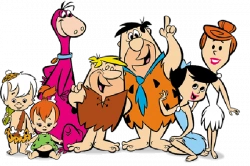
The Flintstones[]
- Frederick Flintstone is the main character of the series. Frederick is an accident-prone bronto-crane operator at the Slate Rock and Gravel Company and the head of the Flintstone household. He is quick to anger (usually over trivial matters), but is a very loving husband and father. He is also good at bowling and is a member of the fictional "Loyal Order Of Water Buffaloes" (Lodge No. 26), a men-only club paralleling real-life fraternities such as the Loyal Order Of Moose. His famous catchphrase is "Yabba Dabba Doo!" He is 44 years old.
- Wilma Flintstone is Frederick's wife and Pebbles' mother. She is more intelligent and level-headed than her husband, though she often has a habit of spending money (with Betty and her catchphrase being "Da-da-da duh da-da CHARGE IT!!"). She often is a foil to Frederick's poor behavior, but is a very loyal wife to him. She is also a woman who is easily if there's even a hint of another woman (especially a pretty one) having anything to do with Frederick. She is 43 years old.
- Pebbles Flintstone is the Flintstones' infant daughter, who is born near the end of the third season.
- Dino is the Flintstones' pet dinosaur that acts like a dog. A running gag in the series involves Frederick coming home from work and Dino getting excited and knocking him down and licking his face repeatedly.
- Baby Puss is the Flintstones' pet saber-toothed cat, which is rarely seen in the actual series but is always seen throwing Frederick out of the house during the end credits, causing Frederick to pound repeatedly on the front door and yell "Wilma!", waking the whole neighborhood in the process.
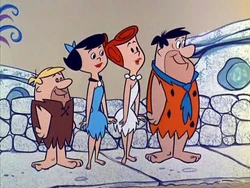
The Rubbles[]
- Barney Rubble is the secondary main character and Frederick's best friend and the next-door neighbor. His occupation is, for the most part of the series, unknown, though later episodes depict him working in the same quarry as Frederick. He shares many of Frederick's interests such as bowling and golf, and is also a member of the "Loyal Order Of Water Buffaloes". Though Frederick and Barney frequently get into feuds with one another (usually due to Frederick's short temper), their deep fraternal bond remains evident. He is 45 years old. In the early 15 episodes of the original series, he had a New Jersey with a New Jersey accent, but was soon changed to a deeper more like chuckle American voice.
- Betty Rubble is Barney's wife and Wilma's best friend. Like Wilma, she, too, has a habit of spending money and also pretty women being around her husband. She speaks in a Midwestern with a Midwestern accent. She is also 43 years old too.
- Bamm-Bamm Rubble is the Rubbles' preternaturally strong adopted son, whom they adopt during the fourth season; his name comes from the only phrase he ever speaks as a baby: "Bamm, Bamm!"
- Hoppy is the Rubbles' pet hopparoo (a kangaroo/dinosaur combination creature), which they purchase at the beginning of the fifth season. When he first arrives, Dino and Frederick mistake him for a giant mouse and are frightened of him, but they eventually become best friends after Hoppy gets help when they are in an accident. He babysits the kids as he takes them around in his pouch, which also serves as a shopping cart for Betty.
Other characters[]
Over 100 other characters appeared throughout the program.
- Mr. George Slate is Frederick and Barney's hot-tempered boss at the gravel pit. Mr. Slate fires Frederick on several occasions throughout the series, only to give him his job back by the end of the episode. A running gag is Slate's ever-changing first name, which was revealed to be Sylvester, Nate, Oscar, and George as the series progressed. In the episode "The Long, Long, Long Weekend" which originally aired on January 21, 1966, he is shown as being the founder of "Slate Rock And Gravel Company"; still in business two million years later, the company is operated by his descendant, "George Slate the Eighty-Thousandth". Note, in the early Flintstones episodes, the more recognized "Mr. Slate" character was known as "Mr. Rockhead" and was a supervisor of Frederick's. Mr. Slate was a short character. During the course of the cartoon, the two men switched identities and the shorter character faded away from existence.
- Arnold is the Flintstones' paperboy, whom Frederick absolutely despises, mainly because Arnold is frequently able to best and outsmart Frederick at a number of tasks and also because he often ("unintentionally") throws the newspaper in Frederick's face. Arnold's parents are mentioned in the series, but his mother Doris, a friend of Wilma and Betty's (as evidenced in the episode "The Little Stranger", which originally aired on November 2, 1962), is referenced in name only, never actually appearing onscreen. Arnold's father, however, did appear in the episode "Take Me Out To The Ball Game", which originally aired on April 27, 1962, though his name is never mentioned.
- Joe Rockhead is a mutual friend of Frederick and Barney. Usually, when Frederick and Barney have some kind of falling out, Frederick mentions doing something (such as going to a baseball game) with Joe. Joe was, at some point, chief of the Bedrock Volunteer Fire Department (as shown on the episode "Arthur Quarry's Dance Class", which originally aired on January 13, 1961). His appearance varied throughout the run of the series, but his appearance in the episode "The Picnic", which originally aired on December 15, 1961, was the one most commonly used.
- Pearl Slaghoople is Wilma's hard-to-please mother, Frederick's mother-in-law and Pebbles' maternal grandmother, who is constantly disapproving of Frederick and his behavior. Their disastrous first meeting was recounted in the episode "Bachelor Daze", which originally aired on March 5, 1964. They briefly reconciled in the episode "Mother-In-Law's Visit", which originally aired on February 1, 1963. That is, until, she found out that she became Frederick's "nice fat pigeon" when he suckered her out of money that he needed to buy a baby crib for Pebbles. They reconciled again at the end of the TV movie I Yabba-Dabba Do!.
- The Great Gazoo is an alien exiled to Earth that helps Frederick and Barney, often against their will. He is actually from the future, and is quite dismayed when he realizes he has been sent back to "The Stone Age". He can only be seen by Frederick, Barney, Pebbles, Bamm-Bamm, other small children, Dino, and Hoppy. Gazoo appeared in the final season only.
- Uncle Tex Hardrock is Frederick's maternal uncle and a member of the Texarock Rangers. He constantly holds Frederick's future inheritance over his head.
- Sam Slagheap Is The Grand Poobah Of The Water Buffalo Lodge.
Voice cast[]
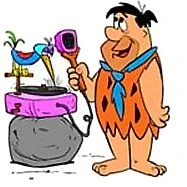
- Frederick Flintstone – Alan Reed
- Wilma Flintstone/Pebbles Flintstone – Jean Vander Pyl
- Barney Rubble – Mel Blanc; Daws Butler (season 2; episodes 1, 2, 5, 6, and 9 only)
- Betty Rubble – Bea Benaderet (seasons 1–4); Gerry Johnson (seasons 5–6)
- Bamm-Bamm Rubble/Hoppy/Arnold – Don Messick
- Dino – Mel Blanc
- Mr. Slate – John Stephenson
- Mrs. Slaghoople – Verna Felton And Janet Waldo
- The Great Gazoo – Harvey Korman
Music[]
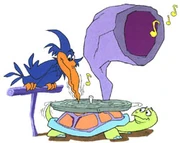
Episodes[]
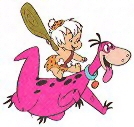
Films and subsequent television series[]
Following the show's cancellation in 1966, a film based upon the series was created. The Man Called Flintstone was a musical spy caper that parodied James Bond and other secret agents. The movie was released to theaters on August 3, 1966, by Columbia Pictures.
The show was revived in the early 1970s with Pebbles and Bamm-Bamm having grown into teenagers, and several different series and made-for-TV movies (broadcast mainly on Saturday mornings, with a few shown in primetime), including a series depicting Frederick and Barney as police officers, another depicting the characters as children, and yet others featuring Frederick and Barney encountering Marvel Comics superhero The Thing and Al Capp's comic strip character Shmoo —have appeared over the years. The original show also was adapted into a live-action film in 1994, and a prequel, The Flintstones In Viva Rock Vegas, which followed in 2000. Unlike its sister show The Jetsons (the two shows appeared in a made-for-TV crossover movie in 1987), the revival programs were not widely syndicated or rerun alongside the original series.
Television series[]
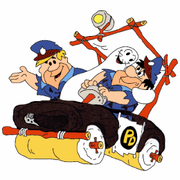
- The Pebbles And Bamm-Bamm Show (1971–72) (one season)
- The Flintstone Comedy Hour (1972–73) (one season)
- The Flintstone Comedy Show (1973–74) (compilation series)
- Frederick Flintstone And Friends (1977–78) (compilation series)
- The New Frederick And Barney Show (1979) (one season)
- Frederick And Barney Meet The Thing (1979) (one season)
- Frederick And Barney Meet The Shmoo (1979–80) (one season)
- The Flintstone Comedy Show (1980–82) (two seasons)
- The Flintstone Funnies (1982–84) (compilation series)
- The Flintstone Kids (1986–88) (two seasons)
- What A Cartoon! – featuring Dino: Stay Out! (1995) and Dino: The Great Egg-scape (1997)
- Cave Kids (1996) (one season)
- Yabba-Dabba Dinosaurs
Theatrical animated feature[]
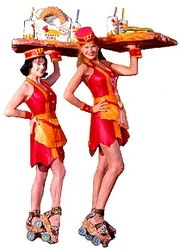
- The Man Called Flintstone (1966, released by Columbia Pictures)
Television specials[]
- The Flintstones On Ice (1973)
- A Flintstone Christmas (1977)
- Hanna-Barbera's All-Star Comedy Ice Revue (1978)
- The Flintstones: Little Big League (1978)
- The Flintstones Meet Rockula And Frankenstone (1980)
- The Flintstones' New Neighbors (1980)
- The Flintstones: Frederick's Final Fling (1980)
- The Flintstones: Wind-Up Wilma (1981)
- The Flintstones: Jogging Fever (1981)
- The Flintstones' Twenty-Fifth Anniversary Celebration (1986)
- The Flintstone Kids' "Just Say No" Special (1988)
- Hanna-Barbera's Fiftieth: A Yabba Dabba Doo Celebration (1989)
- A Flintstones Family Christmas (1993)
Television films[]
- The Jetsons Meet The Flintstones (1987)
- I Yabba-Dabba Doo! (1993)
- Hollyrock-A-Bye Baby (1993)
- A Flintstones Christmas Carol (1994)
- The Flintstones: On The Rocks (2001)
Educational films[]
- Energy: A National Issue (1977)
- Hanna-Barbera Educational Filmstrips
- Bamm-Bamm: Term Paper (1978)
- Bamm-Bamm: Information Please (1979)
- The Flintstones: A Weighty Problem (1980)
- The Flintstones: Fire Alarm (1980)
- The Flintstones: Fire Escape (1980)
- The Flintstones: Driving Guide (1980)
Live-action films[]
- The Flintstones (1994)
- The Flintstones In Viva Rock Vegas (2000)
Direct-to-video films[]
Other media[]
- For a list of DVDs, video games, comic books, and VHS releases, see List of The Flintstones media.
Theme parks[]
Two Flintstones-themed amusement parks exist in the United States: Bedrock City in Custer, South Dakota, and another in Valle, Arizona. The one near Williams Arizona is still open for the summer of 2019 but slated to close by 2020. It cost $5 per person to get in. Both have been in operation for decades. Bedrock City, also known as Flintstone Park, closed in August 2015.
Another existed until the 1990s at Carowinds in Charlotte, North Carolina. In Canada, Flintstone Park in Kelowna, British Columbia, opened in 1968 and closed in 1998; it was notable for the "Forty Foot Frederick" billboard of Frederick Flintstone which was a well-known Kelowna landmark. Another The Flintstones Park was located in Bridal Falls, British Columbia, which closed in 1990. Calaway Park outside Calgary, Alberta, also opened with a The Flintstones theme and many of the buildings today have a caveman-like design, though the park no longer licenses the characters. The Australia's Wonderland and Canada's Wonderland theme parks, both featured The Flintstones characters in their Hanna-Barbera-themed children's sections from 1985 until the mid-1990s. Kings Island (near Cincinnati, Ohio) and Kings Dominion (near Richmond, Virginia) had a Hanna-Barbera land, in which many Hanna-Barbera characters were featured, including The Flintstones, in the 1980s and early 1990s.
Live theater[]
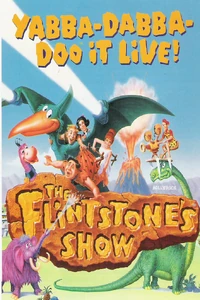
The Flintstone's Show artwork poster.
A stage production opened at Universal Studios Hollywood in 1994 (the year the live-action film was released), developed by Universal and Hanna-Barbera Productions. It opened at the Panasonic Theater, replacing the Star Trek show. The story consists of Frederick, Wilma, Barney, and Betty heading for "Hollyrock". The show ran until January 2, 1997.
Foreign versions[]
The series was translated into several languages.
The Hungarian version was written by József Romhányi in the 1960s. Romhányi was a well-known poet, writer and translator with the speciality of extreme word-play and he rewrote the whole cartoon in rhyming form full of wordplays and puns. It became so popular that many lines found their way into popular culture or became adages. The Hungarian publisher released the series in the 1990s with new dubbing, which resulted in a backlash from fans demanding the original dubbing. The studio did not have all the original voice material and they asked the general public to provide them the original copies of the series, so the original dub was re-recorded and later released on a DVD version in the 2000s.


